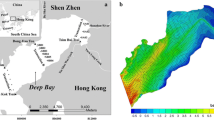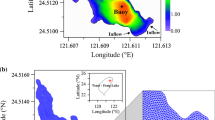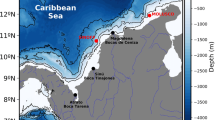Abstract
We modified the sediment incipient motion in a numerical model and evaluated the impact of this modification using a study case of the coastal area around Weihai, China. The modified and unmodified versions of the model were validated by comparing simulated and observed data of currents, waves, and suspended sediment concentrations (SSC) measured from July 25th to July 26th, 2006. A fitted Shields diagram was introduced into the sediment model so that the critical erosional shear stress could vary with time. Thus, the simulated SSC patterns were improved to more closely reflect the observed values, so that the relative error of the variation range decreased by up to 34.5% and the relative error of simulated temporally averaged SSC decreased by up to 36%. In the modified model, the critical shear stress values of the simulated silt with a diameter of 0.035 mm and mud with a diameter of 0.004 mm varied from 0.05 to 0.13 N/m2, and from 0.05 to 0.14 N/m2, respectively, instead of remaining constant in the unmodified model. Besides, a method of applying spatially varying fractions of the mixed grain size sediment improved the simulated SSC distribution to fit better to the remote sensing map and reproduced the zonal area with high SSC between Heini Bay and the erosion groove in the modified model. The Relative Mean Absolute Error was reduced by between 6% and 79%, depending on the regional attributes when we used the modified method to simulate incipient sediment motion. But the modification achieved the higher accuracy in this study at a cost of computation speed decreasing by 1.52%.
Similar content being viewed by others
References
Aldridge J N. 1996. Optimal fitting of a model to observations of sediment concentrations in the Irish Sea. In: Spalding M L, Cheng R T eds. Estuarine and Coastal Modelling Proceedings of the 4th international conference. American Society of Civil Engineers, San Diego, USA. p.417–428.
Amos C L, Umgiesser G, Ferrarin C, Thompson C E L, Whitehouse R J S, Sutherland T F, Bergamasco A. 2010. The erosion rates of cohesive sediments in Venice lagoon, Italy. Continental Shelf Research, 30 (8): 859–870.
Andersen T J, Fredsoe J, Pejrup M. 2007. In situ estimation of erosion and deposition thresholds by Acoustic Doppler Velocimeter (ADV). Estuarine, Coastal and Shelf Science, 75 (3): 327–336.
Ariathurai R, Arulanandan K. 1978. Erosion rates of cohesive soils. Journal of the Hydraulics Division, 104 (2): 279–283.
Bass S J, Aldridge J N, Mccave I N, Vincent C E. 2002. Phase relationships between fine sediment suspensions and tidal currents in coastal seas. Journal of Geophysical Research: Oceans, 107 (C10): 10-1-10-14.
Berlamont J, Ockenden M, Toorman E, Winterwerp J. 1993. The characterisation of cohesive sediment properties. Coastal Engineering, 21 (1–3): 105–128.
Bian S H, Hu Z J, Liu J Q, Zhu Z C. 2017. Sediment suspension and the dynamic mechanism during storms in the Yellow River Delta. Environmental Monitoring and Assessment, 189 (1): 3.
Booij N, Ris R C, Holthuijsen L H. 1999. A third-generation wave model for coastal regions: 1. Model description and validation. Journal of Geophysical Research: Oceans, 104 (C4): 7 649–7 666.
Buffington, J M. 2000. The Legend of A. F. Shields. Journal of Hydraulic Engineering, 125 (4): 376–387.
Bui M D, Hans H B, Horst K. 2005. Morphological numerical simulation of flood situations in the Danube River. International Journal of River Basin Management, 3 (4): 283–293.
Cao Z X, Pender G, Meng J. 2006. Explicit formulation of the Shields diagram for incipient motion of sediment. Journal of Hydraulic Engineering, 132 (10): 1 097–1 099.
Carniello L, Defina A, D’Alpaos L. 2012. Modeling sand-mud transport induced by tidal currents and wind waves in shallow microtidal basins: application to the Venice Lagoon (Italy). Estuarine Coastal and Shelf Science, 102–103: 105–115.
Chao X B, Jia Y F, Shields Jr F D, Wang S S Y, Cooper C M. 2008. Three-dimensional numerical modeling of cohesive sediment transport and wind wave impact in a shallow oxbow lake. Advances in Water Resources, 31 (7): 1 004–1 014.
Chen C S, Beardsley R C, Cowles G et al. 2013. An unstructured grid, finite-volume community ocean model FVCOM user manual, SMAST/UMASSD-13-0701. New Bedford, Mass. https://doi.org/fvcom.smast.umassd.edu/fvcom/.
Chen C S, Beardsley R C, Cowles G. 2006. An unstructured grid, finite-volume coastal ocean model (FVCOM) system. Oceanography, 19 (1): 78–89.
Chen J Y, Li D J, Chen B L, Hu F X, Zhu H F, Liu C Z. 1999. The processes of dynamic sedimentation in the Changjiang Estuary. Journal of Sea Research, 41 (1–2): 129–140.
Chen S L, Zhang G A, Yang S L, Yu Z Y. 2004. Temporal and spatial changes of suspended sediment concentration and resuspension in the Yangtze River Estuary and its adjacent waters. Acta Geographica Sinica, 59 (2): 260–266. (in Chinese with English abstract)
Dai Q, Liu C J, Hu J, Zhang Z H. 2014. Study on the curvefitting for the Shields diagram and its uncertainty. Journal of Sediment Research, (6): 19–24. (in Chinese with English abstract).
de Linares M, Belleudy P. 2007. Critical shear stress of bimodal sediment in sand-gravel rivers. Journal of Hydraulic Engineering, 133 (5): 555–559.
Dohmen-Janssen C M. 1999. Grain Size Influence on Sediment Transport in Oscillatory Sheet Flow, Phase-Lags and Mobile-Bed Effects. Delft University of Technology, Delft, Netherlands. p.150–151.
Droppo I G, D’Andrea L, Krishnappan B G, Jaskot C, Trapp B, Basuvaraj M, Liss S N. 2015. Fine-sediment dynamics: towards an improved understanding of sediment erosion and transport. Journal of Soils and Sediments, 15 (2): 467–479.
Duc B M, Bernhart H H, Kleemeier H. 2005. Morphological numerical simulation of flood situations in the Danube River. International Journal of River Basin Management, 3 (4): 283–293.
Fettweis M. 2008. Uncertainty of excess density and settling velocity of mud flocs derived from in situ measurements. Estuarine, Coastal and Shelf Science, 78 (2): 426–436.
Ge J Z, Chen C S, Qi J H, Ding P X, Beardsley R C. 2012. A dike-groyne algorithm in a terrain-following coordinate ocean model (FVCOM): development, validation and application. Ocean Modelling, 47: 26–40.
Ge J Z, Shen F, Guo W Y, Chen C S, Ding P X. 2015. Estimation of critical shear stress for erosion in the Changjiang Estuary: a synergy research of observation, GOCI sensing and modeling. Journal of Geophysical Research: Oceans, 120 (12): 8 439–8 465.
Heath M, Sabatino A, Serpetti N, Murray R O. 2015. Scoping the impact tidal and wave energy extraction on suspended sediment concentrations and underwater light climate. Terawatt Position Papers.
Houwing E J, van Rijn L C. 1998. In Situ Erosion Flume (ISEF): determination of bed-shear stress and erosion of a kaolinite bed. Journal of Sea Research, 39 (3–4): 243–253.
Houwing E J. 1999. Determination of the critical erosion threshold of cohesive sediments on intertidal mudflats along the Dutch Wadden Sea Coast. Estuarine, Coastal and Shelf Science, 49 (4): 545–555.
Jacobs W, Le Hir P, van Kesteren W, Cann P. 2011. Erosion threshold of sand-mud mixtures. Continental Shelf Research, 31 (S10): S14-S25.
Jago C F, Jones S E. 1998. Observation and modelling of the dynamics of benthic fluffresuspended from a sandy bed in the southern North Sea. Continental Shelf Research, 18 (11): 1 255–1 282.
Kennedy J F. 1995. The albert shields story. Journal of Hydraulic Engineering, 121 (11): 766–772.
Kim S C, Friedrichs C T, Maa J P Y, Wright L D. 2000. Estimating bottom stress in tidal boundary layer from acoustic Doppler velocimeter data. Journal of Hydraulic Engineering, 126 (6): 399–406.
Lanuru M. 2008. Measuring critical erosion shear stress of intertidal sediments with eromes erosion device. Fakultas Ilmu Kelautan Dan Perikanan Unhas, 18 (5): 390–397.
Liu Y X, Huang H J, Fan J Y, Yang S J. 2009. Detection of distribution change and diffusion of suspended sediment concentration around Heini Bay. Marine Sciences, 33 (1): 25–29. (in Chinese with English abstract).
Lumborg U, Windelin A. 2003. Hydrography and cohesive sediment modelling: application to the Rømø Dyb tidal area. Journal of Marine Systems, 38 (3–4): 287–303.
Lund-Hansen L C, Christiansen C, Jensen O, Laima M. 1999. The LABEREX chamber for studying the critical shear stress for fine-grained sediment. Geografisk Tidsskrift-Danish Journal of Geography, 99 (1): 1–7.
Pouv K S, Besq A, Guillou S S, Toorman E A. 2014. On cohesive sediment erosion: a first experimental study of the local processes using transparent model materials. Advances in Water Resources, 72: 71–83.
Prandle D. 1997. Tidal characteristics of suspended sediment concentrations. Journal of Hydraulic Engineering, 123 (4): 341–350.
Pritchard D. 2005. Suspended sediment transport along an idealised tidal embayment: settling lag, residual transport and the interpretation of tidal signals. Ocean Dynamics, 55 (2): 124–136.
Schmelter M L, Wilcock P, Hooten M, Stevens D K. 2015. Multi-fraction Bayesian sediment transport model. Journal of Marine Science and Engineering, 3 (3): 1 066–1 092.
Soulsby R L, Whitehouse R J S W. 1997. Threshold of sediment motion in coastal environments. In: Pacific Coasts and Ports. Christchurch, New Zealand. p.149–154.
State Oceanic Administration, National Administration of Surveying, Mapping and Geoinformation. 1990. Atlas of China’s coastal zones and tideland resources survey: The second volume of Shandong Province. (in Chinese).
SWAN Team. 2006. SWAN Cycle III version 40.51. SWAN technical documentation. Delft University of Technology, Delft, The Netherlands.
van Rijn L C, Walstra D J R, Grasmeijer B et al. 2003. The predictability of cross-shore bed evolution of sandy beaches at the time scale of storms and seasons using process-based Profile models. Coastal Engineering, 47 (3): 295–327.
Vanoni V A. 1964. Measurements of critical shear stress for entraining fine sediments in a boundary layer. California Institute of Technology, Pasadena.
Warner J C, Sherwood C R, Signell R P, Harris C K, Arango H G. 2008. Development of a three-dimensional, regional, coupled wave, current, and sediment-transport model. Computers & Geosciences, 34 (10): 1 284–1 306.
Williamson H, Ockenden M. 1996. ISIS: an instrument for measuring erosion shear stress in situ. Estuarine, Coastal and Shelf Science, 42 (1): 1–18.
Winterwerp J C, Manning A J, Martens C, de Mulder T, Vanlede J. 2006. A heuristic formula for turbulenceinduced flocculation of cohesive sediment. Estuarine, Coastal and Shelf Science, 68 (1–2): 195–207.
Xie M X, Zhang W, Guo W J. 2010. A validation concept for cohesive sediment transport model and application on Lianyungang harbor, China. Coastal Engineering, 57 (6): 585–596.
Yamashita S, Nakajo T, Naruse H. 2009. Reconstruction of sediment transport pathways in modern microtidal sand flat by multiple classification analysis. Acer National & International Surveys, 2.
Yin C, Huang H J, Yan L W. 2013. Numerical simulation of random wave-induced erosion and deposition pattern in the Heini Bay. Marine Geology Frontiers, 29 (5): 6–12. (in Chinese with English abstract)
Yin C. 2013. Numerical Simulation on Random Wave-Induced Erosion and Evolution in the Heini Bay. University of Chinese Academy of Sciences, Qingdao, China. p.18–19. (in Chinese with English abstract)
Zhang Z H, Huang H J, Liu Y X, Yan L W, Wang E K. 2016. Effects of suspended culture of the seaweed Laminaria Japonica Aresch on the flow structure and suspended sediment transport. Advances in Marine Science, 34 (1): 37–49. (in Chinese with English abstract)
Acknowledgement
The authors appreciate the helpful comments and suggestions provided by Mr. CHI Wanqing and Doctor ZENG Ming. The advices helped us with improving this paper.
Author information
Authors and Affiliations
Corresponding author
Additional information
Supported by the National Natural Science Foundation of China (Nos. 41276084, 41406100)
Rights and permissions
About this article
Cite this article
Zhu, Z., Wang, Y., Bian, S. et al. A method for simulating sediment incipient motion varying with time and space in an ocean model (FVCOM): development and validation. J. Ocean. Limnol. 36, 1216–1235 (2018). https://doi.org/10.1007/s00343-018-7096-7
Received:
Accepted:
Published:
Issue Date:
DOI: https://doi.org/10.1007/s00343-018-7096-7




